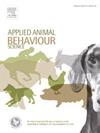Impact of restraining position on tonic immobility in broiler chickens and mule ducks
IF 2.2
2区 农林科学
Q1 AGRICULTURE, DAIRY & ANIMAL SCIENCE
引用次数: 0
Abstract
Tonic immobility (TI) test is used to assess the fearfulness of birds. However, its outcomes depend on many factors including the breed, species, and restraining position. This study aimed primarily to evaluate the effect of different restraining treatments on TI parameters in both chickens and ducks. Secondarily, it aimed to identify the associations between various variables measured in this study including body weight, handling time, induction attempts, and TI response. Two separate experiments were conducted in broiler chickens and mule ducks. TI was performed on ground level in chickens and on a U-shaped cradle in ducks. Briefly, 30 broiler chickens (34 d of age) and 18 mule ducks (55 d of age) were randomly assigned to three restraining treatments: left lateral position (LLP), right lateral position (RLP), and back or dorsal position (DP). The variables measured in both experiments were body weight (BW), handling time, number of attempts needed to induce TI (NOA), and TI duration. In chicken, fewer NOA were needed to induce TI in RLP treatment compared to LLP treatment (P = 0.036), but there was no difference between RLP and DP treatment (P = 0.58) or between DP and LLP (P = 0.67). In ducks, there was a non-significant trend that fewer attempts were needed to induce TI in DP compared to other treatments (P = 0.08). Duration of TI was not affected by restraining treatment in chickens (P = 0.43) nor ducks (P = 0.61). A negative moderate correlation was observed between NOA and BW in chickens (R = - 0.45, P = 0.01), and a positive moderate correlation was observed between TI duration and BW in ducks (R = 0.46, P = 0.05). In conclusion, the RLP was the most effective method to induce TI in chickens on ground level. BW was associated positively with NOA in chickens and negatively with TI duration in ducks.
求助全文
约1分钟内获得全文
求助全文
来源期刊

Applied Animal Behaviour Science
农林科学-行为科学
CiteScore
4.40
自引率
21.70%
发文量
191
审稿时长
18.1 weeks
期刊介绍:
This journal publishes relevant information on the behaviour of domesticated and utilized animals.
Topics covered include:
-Behaviour of farm, zoo and laboratory animals in relation to animal management and welfare
-Behaviour of companion animals in relation to behavioural problems, for example, in relation to the training of dogs for different purposes, in relation to behavioural problems
-Studies of the behaviour of wild animals when these studies are relevant from an applied perspective, for example in relation to wildlife management, pest management or nature conservation
-Methodological studies within relevant fields
The principal subjects are farm, companion and laboratory animals, including, of course, poultry. The journal also deals with the following animal subjects:
-Those involved in any farming system, e.g. deer, rabbits and fur-bearing animals
-Those in ANY form of confinement, e.g. zoos, safari parks and other forms of display
-Feral animals, and any animal species which impinge on farming operations, e.g. as causes of loss or damage
-Species used for hunting, recreation etc. may also be considered as acceptable subjects in some instances
-Laboratory animals, if the material relates to their behavioural requirements
 求助内容:
求助内容: 应助结果提醒方式:
应助结果提醒方式:


